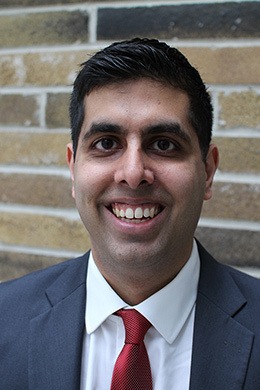 Karim Ladha, MD
Karim Ladha, MDAssociate Professor,
Department of Anesthesiology and Pain Medicine,
University of Toronto;
Staff Anesthesiologist and Clinician Scientist,
St. Michael’s Hospital
Toronto, Ontario, Canada
Dr. Ladha’s Research
Peri-Operative Wearables in Elder Recovery after Surgery (POWERS) Trial
As surgical populations become older and frailer there is an urgent need to re-evaluate how patients, clinicians, researchers and administrators determine preoperative risk and assess optimal recovery after surgery. Personal wearable activity monitors are now readily available and present an important opportunity to improve perioperative care by providing a cost-effective, non-invasive means to risk stratify patients preoperatively and develop new measures of recovery/disability after surgery. Our proposal is to conduct the Peri-Operative Wearables in Elder Recovery after Surgery (POWERS) trial which will be a single arm prospective multi-center cohort study to evaluate the performance of activity monitors as measures of preoperative risk and postoperative recovery of function. The study will enroll two hundred patients who are over the age of 65 and scheduled to undergo elective major non-cardiac surgery with an anticipated length of stay of greater than two days. Each patient will receive an activity monitor for a minimum of one week prior to surgery with the goal of wearing the monitor throughout the postoperative period until ninety days after the operation. Postoperatively, all patients will complete standardized questionnaires at 7, 30 and 90 days to assess disability, quality of life and pain interference. Using advanced statistical techniques, we will define trajectories of activity and sleep in the perioperative period and their associations with postoperative disability and recovery.
Related Publications
Peri-Operative Wearables in Elder Recover after Surgery (POWERS) study: a protocol for a multicentre, prospective cohort study to evaluate perioperative activity with postoperative disability in older adults after non-cardiac surgery.
Ladha KS, Lu J, McIsaac DI, van Vlymen JM, Lebovic G, Ehtesham S, Pazmino-Canizares J, Clarke H, Parotto M, Lorello GR, Wijeysundera DN
The ageing population has led to an increasing proportion of surgical patients with greater frailty and comorbidity. Complications and mortality within 30 days of a surgical procedure are often used to evaluate success in the perioperative period, however, these measures can potentially underestimate a substantial level of morbidity associated with surgery. Personal wearable technologies are now readily available and can offer detailed information on activity intensity, sedentary behaviour and sleeping patterns. These devices may provide important information perioperatively by acting as a non-invasive, and cost-efficient means to risk stratify patients.
This study is a prospective multicentre observational cohort study of 200 older adults (≥65 years) having major elective non-cardiac surgery. The objectives aim to characterise the association between preoperative and postoperative activity monitor measurements with postoperative disability and recovery, as well as characterise trajectories of activity and sleep in the perioperative period. Activity is monitored with the ActiGraph GT3X device and measured for 7-day increments, preoperatively, and at 1 week, 1 month and 3 months postoperatively. Disability will be assessed using the WHO Disability Assessment Schedule 2.0 assessed at 1 week, 1 month and 3 months postoperatively.
Functional decline after major elective non-cardiac surgery: a multicentre prospective cohort study
K S Ladha, B H Cuthbertson, T E F Abbott, R M Pearse, D N Wijeysundera
Self-reported postoperative functional recovery is an important patient-centered outcome that is rarely measured or considered in research and decision-making. We conducted a secondary analysis of the measurement of exercise tolerance before surgery (METS) study for associations of peri-operative variables with functional decline after major non-cardiac surgery. Patients who were at least 40 years old, had or were at risk of, coronary artery disease and who were scheduled for non-cardiac surgery were recruited. Primary outcome was a reduction in mobility, self-care or ability to conduct usual activities (EuroQol 5 dimension) from before surgery to 30 days and 1 year after surgery. A decline in at least one function was reported by 523/1309 (40%) participants at 30 days and 320/1309 (24%) participants at 1 year. Participants who reported higher pre-operative Duke Activity Status indices more often reported functional decline 30 days after surgery and less often reported functional decline 1 year after surgery. The odds ratios (95%CI) of functional decline 30 days and 1 year after surgery with moderate or severe postoperative complications were 1.46 (1.02-2.09), p = 0.037 and 1.44 (0.98-2.13), p = 0.066. Discrimination of participants who reported functional decline 30 days and 1 year after surgery were poor (c-statistic 0.61 and 0.63, respectively). In summary, one quarter of participants reported functional decline up to one postoperative year.
The association between patient-reported pain scores and physical activity in the postoperative period: A prospective observational study
Calvin Diep, Dorothy Wong, Duminda N Wijeysundera, Joel Katz, Hance A Clarke, Karim S Ladha
Highlights of this research article include that no association was found between pain scores and physical activity in postoperative period. Also, the authors found that pain scores alone are not useful indicators of functional status. Finally, wearable activity monitors were found to potentially inform improved quality of recovery after surgery.
Annals for Hospitalists Inpatient Notes – Rethinking the Role of Functional Capacity in Preoperative Risk Stratification
DN Wijeysundera, KS Ladha
Assessment of functional capacity is generally considered to be an integral part of preoperative risk stratification for major surgery. Here, the authors weigh the pros and cons of unstructured questions and objective measures to identify a patient’s presurgical risk for cardiovascular events and death.
International Anesthesia Research Society
